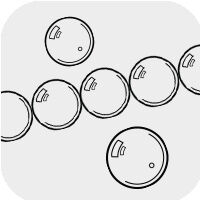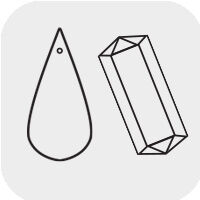Goldstone
Meaning and Properties
Goldstone History
Though not a stone--or gold!--this manufactured "gemstone material" is known by many names: "aventurine glass," stellaria, gold star glass, monkstone or monk's gold. The final two names refer to the urban legend that goldstone was created accidentally by Italian monks in the 1600s. There are earlier samples, however, including a smooth amulet from Iran that dates to the 1100s to 1200s. The earliest written reference to the material we call goldstone, however, is Vincenzo Miotti of Venice being granted exclusive license by the Venetian head of state (the Doge) to create this sparkling opaque glass. It has been linked to the medieval art of alchemy almost from its creation. A deep red variation--called haematinum or purpurin--may have been made by the Romans, with the recipe getting lost during the Dark Ages.
Modern goldstone can be created either with copper flecks or with other metallic compounds such as cobalt, manganese or chromium oxide. These are used in goldstones made using colors (respectively) such as purple, blue and green.
Goldstone Metaphysical Properties
Called the stone of ambition, goldstone is thought to assist in attaining goals. Some consider goldstone to be a symbol of ingenuity, ambition, and drive. It believed to reduce tension, revitalize the wearer and encourage a positive attitude.
Brown goldstone, with its copper content, is believed to carry many of the metaphysical properties of that metal. It is thought to generate and revitalize energy fields, transmit positivity and divert malevolent energy into the earth.
Brown goldstone is associated with the root chakra and the zodiac sign of Sagittarius.
Blue goldstone is believed to transmit healing energy, increase self-acceptance, aid in learning and soothe hypersensitivity. Blue goldstone is thought to be the ideal stone for empaths.
Blue goldstone is associated with the heart and crown chakras and the zodiac sign of Sagittarius.
Goldstone Geological Properties
Goldstone is a type of glittering glass made in a low-oxygen, reducing atmosphere. Goldstone can be polished smooth or carved into beads or other artifacts. Reddish-brown goldstone is the most common form containing tiny crystals of glittering metallic copper. Blue goldstone is achieved by substituting cobalt for copper. The resulting crystals have a more silvery appearance and are suspended in a strongly colored matrix of the corresponding ionic color, resulting in blue goldstone. Manganese substituted for copper results in purple goldstone.
Another common name for the goldstone was aventurine glass, which was sometimes used until the name aventurine was transferred to the natural gemstone--feldspar or quartz with mica inclusions that give a similar glittering appearance. The technical term for this glittering effect is "aventurescence." This makes goldstone one of the few manufactured materials which get its name from similar natural stones.
|
|
|
|
|
|
|
|
|
|
|
|
|
|
|
|
|
|
Proper Care of Goldstone
Like any fine glass, goldstone can be cleaned by dipping it in lukewarm water with a drop of detergent added. Wipe over the surface with a cotton wool ball to remove dirt. Use a soft brush for hard to reach areas. Rinse with clean water by dipping the goldstone into a bowl of lukewarm water without detergent or by wiping with a damp swab. Blot dry using paper towels or a soft cloth.
Designing with Goldstone
Brown goldstone works beautifully with copper beads and findings, or in bold contrast with color-coated Zebra wire in cool blues and greens. Meanwhile, blue goldstone can do the heavy lifting in intricate jewelry designs--especially in pieces where using lapis lazuli would be cost-prohibitive. Green goldstone (an uncommon combination) interacts with both jewel tones and pastels, much like deep green leaves set off colorful flowers.
View more resources featuring goldstone, including Design Ideas, Videos, Tutorials and more!
Shop for Goldstone
**Please note that all metaphysical or healing properties listed are collected from various sources. This information is offered as a service and not meant to treat medical conditions. Fire Mountain Gems and Beads® does not guarantee the validity of any of these statements.
How did you like this resource? Your feedback helps us provide resources that matter to you most.
Copyright Permissions
All works of authorship (articles, videos, tutorials and other creative works) are from the Fire Mountain Gems and Beads® Collection, and permission to copy is granted for non-commercial educational purposes only. All other reproduction requires written permission. For more information, please email copyrightpermission@firemtn.com.



